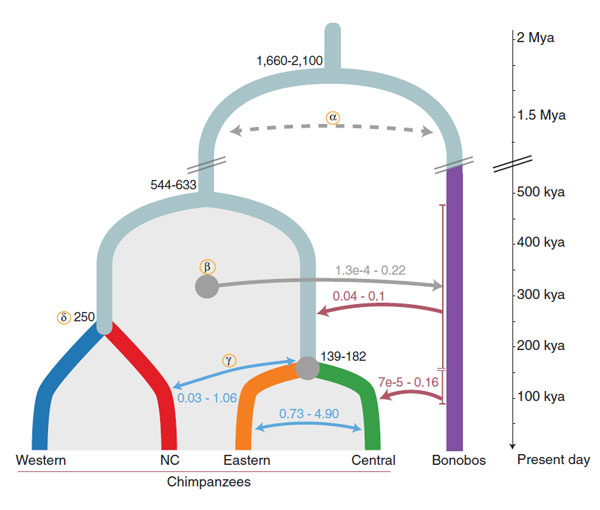Ancient interbreeding between chimpanzees and bonobos revealed

The study also showed that genomics could help reveal the country of origin of individual chimpanzees, which has strong implications for chimpanzee conservation.
Chimpanzees and bonobos are great apes found only in tropical Africa. They are endangered species and are supposedly fully protected by law, yet many chimpanzees and bonobos are captured and held illegally.
To aid the conservation effort, researchers analysed the whole genome sequences of 75 chimpanzees and bonobos, from 10 African countries, and crucially included 40 new wild-born chimpanzees from known geographic locations. They discovered that there was a strong link between the genetic sequence of a chimpanzee, and their geographic origin.
“This is the largest analysis of chimpanzee genomes to date and shows that genetics can be used to locate quite precisely where in the wild a chimpanzee comes from. This can aid the release of illegally captured chimpanzees back into the right place in the wild and provide key evidence for action against the captors.”
Dr Chris Tyler-Smith From the Wellcome Trust Sanger Institute
Chimpanzees and bonobos are the closest living relatives of human beings. They diverged from a common ancestor between 1.5 and 2 million years ago and live in different areas of tropical Africa. Until now, it was thought that gene flow between the species would have been impossible, as they were physically separated by the Congo River.
The study confirmed a main separation between chimpanzees and bonobos approximately 1.5 million years ago, and the presence of four chimpanzee subspecies in different regions. However, the researchers also found there were two additional gene flow events between the chimpanzee and bonobo populations, indicating that at least some individuals found their way across the river.
“We found that central and eastern chimpanzees share significantly more genetic material with bonobos than the other chimpanzee subspecies. These chimpanzees have at least 1% of their genomes derived from bonobos. This shows that there wasn’t a clean separation, but that the initial divergence was followed by occasional episodes of mixing between the species.”
Dr Yali Xue From the Sanger Institute
The study also included researchers from Spain, Copenhagen Zoo and the University of Cambridge and showed that there have been at least two phases of secondary contact, 200-550 thousand years ago and around 150 thousand years ago, mirroring what is believed to have happened during the last 100 thousand years of the evolution of humans.
“This is the first study to reveal that ancient gene flow events happened amongst the living species closest to humans – the bonobos and chimpanzees. It implies that successful breeding between close species might have been actually widespread in the ancestors of humans and living apes.”
Dr Tomàs Marquès-Bonet Leader of the study from the Institute of Biological Evolution (University Pompeu Fabra and CSIC), Barcelona
More information
Funding:
This study was supported by the Ministerio de Economía y Competitividad, the Wellcome Trust, and many other funding bodies. Please see the paper for the full list of funding organisations.
Publications:
Selected websites
Institute of Evolutionary Biology (CSIC-UPF)
The Institute of Evolutionary Biology (IBE) is a joint center between Pompeu Fabra University (UPF) and the Spanish National Research Council (CSIC), and was created in 2008 in Barcelona. IBE researchers study the processes and mechanisms that generate biodiversity, including fields like genetics and molecular evolution, population biology, biology of complex systems and the recovery of ancient DNA.
Wellcome Trust Sanger Institute
The Wellcome Trust Sanger Institute is one of the world’s leading genome centres. Through its ability to conduct research at scale, it is able to engage in bold and long-term exploratory projects that are designed to influence and empower medical science globally. Institute research findings, generated through its own research programmes and through its leading role in international consortia, are being used to develop new diagnostics and treatments for human disease.
Wellcome
Wellcome exists to improve health for everyone by helping great ideas to thrive. We’re a global charitable foundation, both politically and financially independent. We support scientists and researchers, take on big problems, fuel imaginations and spark debate.


